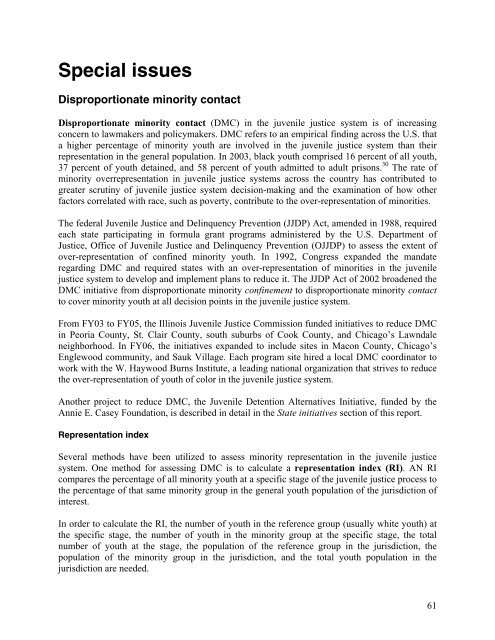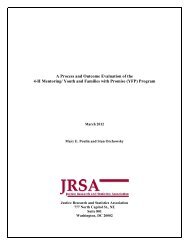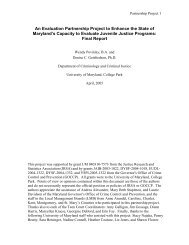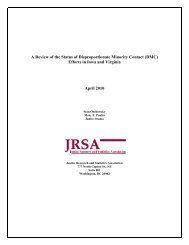Juvenile Justice System and Risk Factor Data - Illinois Criminal ...
Juvenile Justice System and Risk Factor Data - Illinois Criminal ...
Juvenile Justice System and Risk Factor Data - Illinois Criminal ...
Create successful ePaper yourself
Turn your PDF publications into a flip-book with our unique Google optimized e-Paper software.
Special issues<br />
Disproportionate minority contact<br />
Disproportionate minority contact (DMC) in the juvenile justice system is of increasing<br />
concern to lawm akers <strong>and</strong> policymakers. D MC refers to an empirical finding across the U.S. that<br />
a higher percentage of minority youth are involved in the juvenile justice system than their<br />
representation in the general population. In 2003, black youth comprised 16 percent of all youth,<br />
37 percent of youth detained, <strong>and</strong> 58 percent of youth admitted to adult prisons. 30 The rate of<br />
minority overrepresentation in juvenile justice systems across the country has contributed to<br />
greater scrutiny of juvenile justice system decision-making <strong>and</strong> the examination of how other<br />
factors correlated with race, such as poverty, contribute to the over-representation of minorities.<br />
The federal <strong>Juvenile</strong> <strong>Justice</strong> <strong>and</strong> Delinquency Prevention (JJDP) Act, amended in 1988, required<br />
each state participating in formula grant programs administered by the U.S. Department of<br />
<strong>Justice</strong>, Office of <strong>Juvenile</strong> <strong>Justice</strong> <strong>and</strong> Delinquency Prevention (OJJDP) to assess the extent of<br />
over-representation of confined minority youth. In 1992, Congress exp<strong>and</strong>ed the m<strong>and</strong>ate<br />
regarding DMC <strong>and</strong> required states with an over-representation of minorities in the juvenile<br />
justice system to develop <strong>and</strong> implement plans to reduce it. The JJDP Act of 2002 broadened the<br />
DMC initiative from disproportionate minority confinement to disproportionate minority contact<br />
to cover minority youth at all decision points in the juvenile justice system.<br />
From FY03 to FY05, the <strong>Illinois</strong> <strong>Juvenile</strong> <strong>Justice</strong> Commission funded initiatives to reduce DMC<br />
in Peoria County, St. Clair County, south suburbs of Cook County, <strong>and</strong> Chicago’s Lawndale<br />
neighborhood. In FY06, the initiatives exp<strong>and</strong>ed to include sites in Macon County, Chicago’s<br />
Englewood community, <strong>and</strong> Sauk Village. Each program site hired a local DMC coordinator to<br />
work with the W. Haywood Burns Institute, a leading national organization that strives to reduce<br />
the over-representation of youth of color in the juvenile justice system.<br />
Another project to reduce DMC, the <strong>Juvenile</strong> Detention Alternatives Initiative, funded by the<br />
Annie E. Casey Foundation, is described in detail in the State initiatives section of this report.<br />
Representation index<br />
Several methods have been utilized to assess minority representation in the juvenile justice<br />
system. One method for assessing DMC is to calculate a representation index (RI). AN RI<br />
compares the percentage of all minority youth at a specific stage of the juvenile justice process to<br />
the percentage of that same minority group in the general youth population of the jurisdiction of<br />
interest.<br />
In order to calculate the RI, the number of youth in the reference group (usually white youth) at<br />
the specific stage, the number of youth in the minority group at the specific stage, the total<br />
number of youth at the stage, the population of the reference group in the jurisdiction, the<br />
population of the minority group in the jurisdiction, <strong>and</strong> the total youth population in the<br />
jurisdiction are needed.<br />
61

















